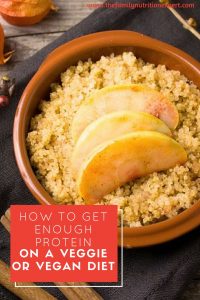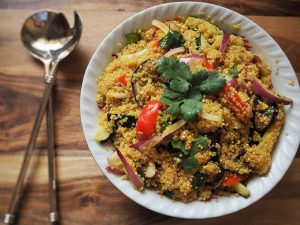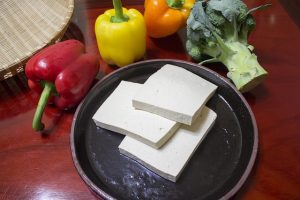 Being a vegetarian or vegan can be really good for your health, but if you choose to exclude meat, fish, eggs and dairy from your diet, then you’ll need to make sure you’re replacing the nutrients in those foods.
Being a vegetarian or vegan can be really good for your health, but if you choose to exclude meat, fish, eggs and dairy from your diet, then you’ll need to make sure you’re replacing the nutrients in those foods.
It’s not enough just to grate a bit of cheese over your food or add a sprinkle of nuts and hope for the best. Honestly, I see a lot of veggies doing this, and it won’t be good for your health long term.
A vegetarian or vegan diet can be very healthy, as long as it’s well planned and thought through. Don’t let yourself fall into the trap of being a “cheese on toast” vegetarian or a vegan who relies on artificial fake meat products.… here are my top tips on how to make sure you get enough protein in your diet.
Do I need to protein combine?
Amino acids are the building blocks of protein, and there are 9 essential amino acids which we must get from our diet. Our bodies simply cannot make them… and we need these amino acids for healing and repair, building tissues such as bones, hair and nails, even to make our DNA. Unfortunately, there are few vegan sources which have all the essential amino acids, and if we don’t get enough of one amino acid, then we may limit the amount of the other essential amino acids we can absorb and use.
It used to be believed that we need to combine different essential amino acids at the same meal, to ensure that we do not have a limiting amino acid which prevents absorption. However, we now know that we have an amino acid pool, which means as long as we’re eating a variety of different protein sources across the day, then we’ll be able to absorb all the essential amino acids.
This is why it’s vital to ensure you’re getting plenty of variety in your diet.
Vegan and Vegetarian Protein Sources
If you’re a vegetarian, you may still be eating dairy and eggs. These provide complete proteins that combine all the essential amino acids, as well as B12. However, don’t rely on cheese for your protein source. It’s not a good idea to be eating a lot of cheese, as it’s high in salt and saturated fat. Instead look for a variety of soft and hard cheeses, plus eggs, as well as other vegan sources of protein (see below).
I tend to recommend that you use cheese more as a flavouring in food – to grate on top of things to add some flavour – rather than thinking of hard cheese as a protein source.
For vegans and veggies, there are several ‘complete plan proteins’ which provide all of the essential amino acids. These are especially important on a vegan diet, and should be included regularly in your diet. Here’s my top three:
 Quinoa
Quinoa
This magical grain is actually a seed, and was used by the Incas to power them up the Andes. It is a complete protein that is rich in B vitamins, fibre, iron, magnesium, and manganese. You can either boil the grain yourself (I recommend 12 minutes, not the 20 minutes put on most packets), and then let it sit off the heat with the lid on. You can also now buy it ready cooked, either to use cold or heated in the microwave or sautéed. I like to throw some into my salad for extra crunch and texture. I also use quinoa flakes in my flapjacks for added protein, as well as quinoa flour in baking.
Take a look at my quinoa tabbouleh recipe. It’s delicious!
Buckwheat
Another complete protein, that comes as groats, which you boil up and can be used to stuff vegetables or as a nutty rice replacement. I often use buckwheat flour to make breakfast pancakes (link to my post on Facebook) or I add the flakes to flapjacks or my home-made granola or muesli. Buckwheat is a great source of rutin, which is essential for our capillary strength.
 Soy
Soy
Beans are often low in the amino acid methionine, but soy is a complete protein. Tofu is a great way to include soy in your diet, and the firm tofu is highest in protein, as well as being rich in calcium and plant oestrogens. I do also love silken tofu, and use it regularly to make a silken berry tofu smoothie. (Just blitz up some silken tofu with some berries, bit of vanilla and almond milk). It’s also brilliant for making cheesecakes.
Should I use quorn?
I’m not a huge fan of quorn and other artificial meat products, because they are very artificial and highly processed. Just have a look at the packaging… do you actually recognise any of those ingredients? I’m also dubious about something being made to look like something it’s not… why do you want to eat products made to look like meat?
I know veggie sausages and the odd bit of quorn can be useful, so I’m not saying never eat it. But I’d rather encourage you to eat natural unprocessed foods made from whole ingredients. Why not try making your own veggie burgers from things like peas, lentils, beans and quinoa?
Find out how in my recipe for Veggie Burgers here.
What else provides me with protein?
Aside from the complete vegan protein sources, you’ll also be able to get lots of protein from the following:
- Beans and pulses – I tend to buy mine in tins for speed, just give them a rinse before you use them. I also add dried red lentils straight into soups and stews.
- Nuts and seeds – a must on a veggie and vegan diet, to ensure you’re getting enough omega 3 fats. More about this next week!
- Wholegrains such as brown rice and whole wheat products – a great way to make a complete protein within a meal. Most beans are low in methionine and high in lysine, and rice is low in lysine and high in methionine. So, put them together, add in some veggies and you have a perfect meal!
- Avocados – another surprisingly protein rich food, as we all tend to focus on the fat in avocados. But a great way to top up your protein intake.
Sneak Peek… I’m currently looking at how I can transform my popular live workshop How to Be a Healthy Vegetarian or Vegan into an online course! To be the first to hear about this new nutritional course, drop your email into the box below.